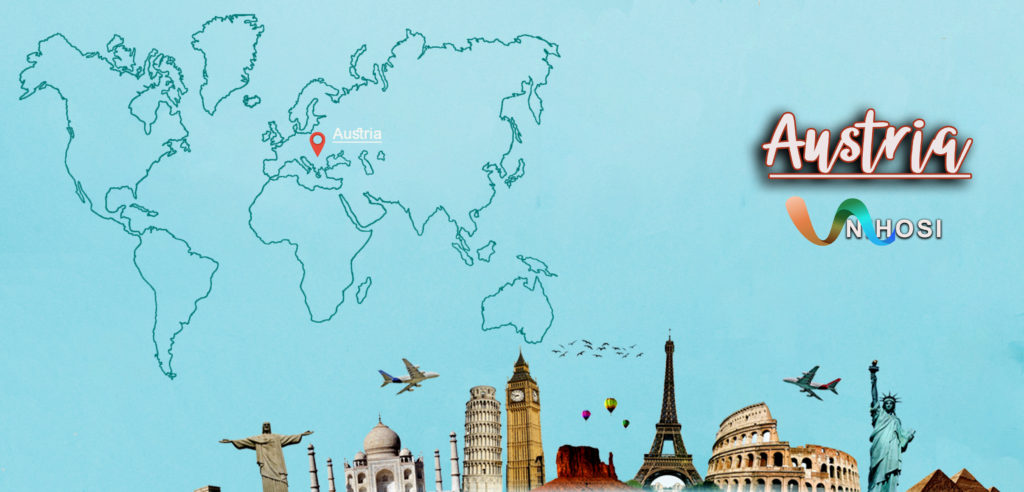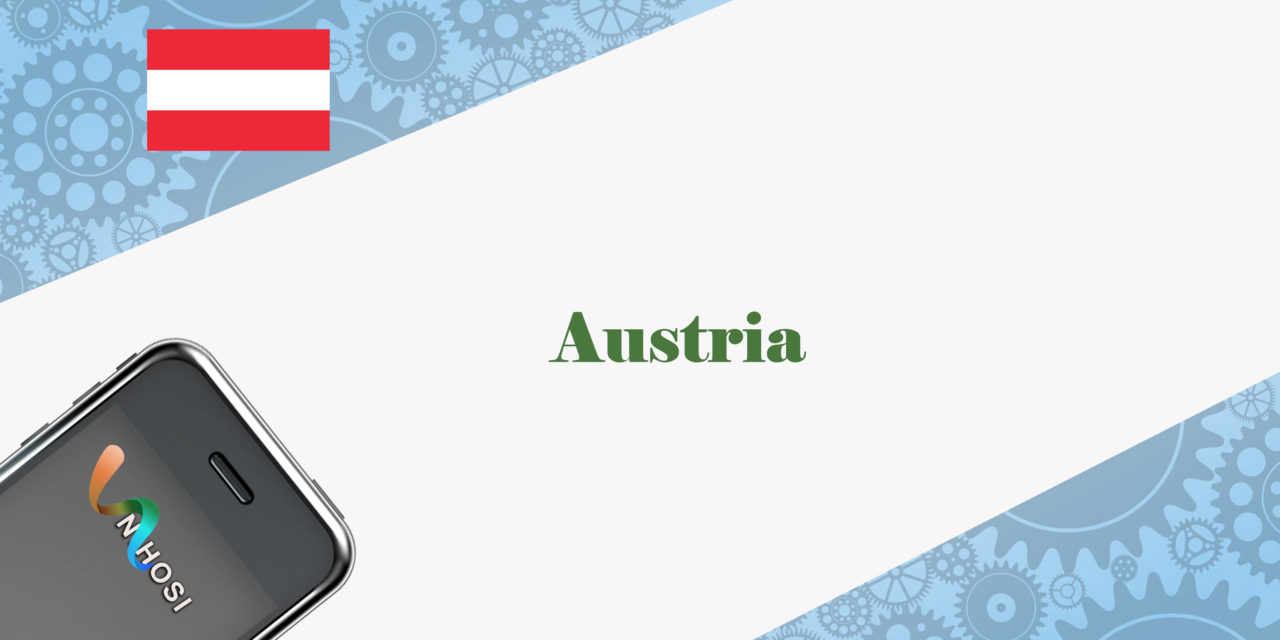Austria is a very tiny nation located in the middle of Europe. 8.46 million individuals make up the population. The principal city is Vienna. The form of government in place is a federation, sometimes known as a parliamentary republic. In the north, it is bordered by the Czech Republic and Germany. In the east, it is bordered by Slovakia and Hungary. In the south, it is bordered by Slovenia and Italy. In the west, it is bordered by Switzerland and Liechtenstein. The capital and biggest city of Austria is Vienna, which has a population of over 1.8 million people. The nominal gross domestic product of Austria is $46,972, making it the richest nation in the world. (2018 est.)
Austria has a total land area of 83,878 km2 with a climate that is classified as temperate alpine. A total of 32,385 square miles of land make up Austria’s territory. Only 32 per cent of Austria is below 500 meters in elevation, while the Grossglockner, the country’s highest peak, is 3,798 meters above sea level. The Alps dominate the landscape of Austria, which is hilly (12,460 ft). Burgenland, Carinthia, Lower Austria, Upper Austria, Salzburg, Styria, Tyrol, Vorarlberg, and Vienna are the nine autonomous federal states that makeup Austria, which is a federal republic made of nine distinct federal states (sometimes referred to as provinces).

Austria
Geography
Austria is a tiny country in Central Europe that has a total area of 83,871 square kilometres. It is surrounded by the Czech Republic and Germany to the north, Hungary and Slovakia to the east, Slovenia and Italy to the south, and Switzerland and Liechtenstein to the west. The landmass of Austria is laid out in the form of a wedge, which widens toward the east and tapers toward the west, creating an appearance similar to that of a bunch of grapes.
Over three-quarters of the landmass of the nation is comprised of the Eastern Alps and its foothills, which rise to an elevation of 3,797 meters atop the Grossglockner. Mountain ranges are separated by a series of deep valleys that run longitudinally. The Vienna Basin and the western half of the Middle Danube Plain are both found in the eastern part of the nation. Principal rivers include the Danube, which is 350 kilometres long, as well as its tributaries, the Inn, Drava, and Morava. The largest lakes in Austria are Constance and the Neusiedler See, while Austria overall contains around 580 lakes. Nearly half of Austria is covered with trees and other types of vegetation. The natural reserves Neusiedlersee-Seewinkel, Karwendelgebirge, and others are responsible for the protection of the beautiful scenery.
Climate
The climate is moderate, transitional to continental, and extremely height dependent. Winters are moderate, with regular snowfalls; the coldest month is January, with temperatures dropping to -2 ° C in valleys and -14 ° C in mountainous parts. Summer temperatures in the east of Austria (Vienna) reach +30 ° C, whereas, in the west, midday air temperatures only reach +21… + 23 ° C. Most resorts have a ski season that lasts from November to mid-April.
Time
UTC +1 is the time zone (in winter it is 2 hours, and in summer it is 1 hour less than in Minsk ).
Currency unit
The Euro (EUR). On Mondays, Tuesdays, Wednesdays, and Fridays, Austrian banks are open from 08:00 to 12:00 and from 13:00 to 15:00, while on Thursdays, they are open from 08:00 to 12:30 and from 13:30 to 17:30. Austrian banks are closed on all other days. Exchange offices at train stations are open until 22:00. Almost all significant hotels and stores accept Visa, American Express, and Master Card as the main forms of payment.
Austrian cuisine
The cuisine of Austria is quite traditional while at the same time displaying a great deal of regional diversity throughout the nation. Since it contains characteristics of Celtic, Italian, German, Hungarian, Slavic, and Mediterranean cuisine, the regional cuisine is often regarded as being among the most varied and unique in all of Europe. In addition, the majority of the time, its name is not Austrian cuisine but rather a Viennese cuisine, emphasizing the preeminent position of the capital as a site where multiple aspects of different ethnicities have melded together.
Traditional Austrian sweets include the world-famous apple strudel, rum pie, Salzburger Nockerln soufflé, white bread Armeritter cooked in an egg with jam and sugar, pancakes, and chocolate cake. Sachertorten. Schinkenfleckerln, which consists of ham noodles, cheese, and egg white, is a dish that is well-liked throughout the nation.
The imposing symbol of Viennan cuisine, the gigantic fried veal loaves, is worth mentioning. Vegetable salads and bone meat are often served beside the sign. In addition to Bakhun chicken brown, you should try Tafelspitz boiling beef, Nokerl scrambling Kaiserschmarrn, and cheese soup, as well as preserved ham and goose liver.
While in Germany, you should try gluwein (which is not to be mistaken with spiced wine; it is a hot drink made from equal parts red wine and water), weizenbeer, and the national soda, herbal lemonade almdudler. Coffee is a given, too. Ferlengerter is a lesser double espresso, followed by Merchant, Ferlengerter, Melange, and Einspenner, which all include milk and whipped cream. Einspenner is a tall glass of double mocha.
Tourist centres
When it comes to recreation, Austria has a lot to offer: in the winter, there is a slew of ski resorts available; in the summer, you can cool down on one of the country’s many lakes and enjoy not just swimming and sunbathing but also several other active leisure activities. In addition to major ski resorts, we also provide a unique tour of Austrian towns, including Vienna, Innsbruck, Salzburg, and Graz, among other fascinating locales to see during your stay.
Innsbruck
It is situated in the Inn Valley, surrounded by magnificent mountain ranges, and is the capital of Tyrol. This little mountain town has hosted the Winter Olympics twice and served as the home of the Habsburg dynasty throughout its history. In addition to a wide range of lodgings, motels, and dining options, there is a slew of buildings with the prefix “Olympic” on their names. One of Innsbruck’s most iconic landmarks is the Herzog – Friedrich – Straße building’s Golden Roof. After the historic town hall, another well-known sight in town is the Stadtturm, the city’s clocktower. The Baroque Cathedral of St. Jacob and the Wiltener Basilica are among the city’s other notable temple structures, along with the Hofkirche Cathedral, which houses the Kaiser Maximilian I mausoleum. It’s also worth mentioning the “Alpenzoo,” which is considered Europe’s tallest peak (727 m). Innsbruck’s nearby Swarovski Museum is another great attraction worth seeing while you’re there. Visitors may expect a spectacular experience and a glimpse into the mystifying crystal worlds below the earth.
Graz
It is the second-largest city in Austria after Vienna and is situated in the southeastern region. Additionally, Graz has gained notoriety in the modern era since Arnold Schwarzenegger was born and raised there. In terms of cultural significance, Graz’s old town is unparalleled. Throughout the neighbourhood, you’ll find a mix of Gothic and contemporary architecture. Graz’s most notable landmarks are the Schlossberg castle and the Urturm clock tower, which sits atop a mountain at a height of 475 metres above sea level and serves as the city’s unofficial emblem. There is also a Renaissance-style Landhouse Parliament building, a 17th-century mausoleum, and a contemporary art museum in Vienna. Near the Cathedral of St. Egidius in Graz, there is the Graz Castle, which is a UNESCO World Heritage Site, and the Eggenberg Castle, which is situated outside of Graz.
Vienna
The city of Vienna is one of Europe’s most beautiful. It is a city of opulent palaces, stately squares, and lovely streets bordered by the Vienna Woods. Most people visiting Vienna will want to see St. Stephen’s Cathedral (built in the XII century), as well as the adjacent St. Peter’s Church and the Hofburg Palace, which served as the Habsburgs’ official home. Also notable are the State Museum of Art, Belvedere Palace, Schönbrunn (“Beautiful Castle”), Vienna Opera, Burgtheater, and the Vienna State Opera. In all, there are more than 80 museums in the city. The Hundertwasser apartment complex is one of Vienna’s most recognisable contemporary landmarks… There are an incredible amount of floors, the ceiling is covered with dirt and grass, and some chambers even have trees in them. Apart from that, Vienna is an absolute haven for coffee and dessert lovers alike: the city’s plethora of coffee shops and eateries is legendary.
Salzburg
Located in western Austria, Salzburg is the country’s fourth-largest city and one of the most attractive. Bishops and Mozart call Salzburg home. The Salzach River flows through the city, which is situated near the Alps. The city of Salzburg has both a historic and a modern side. Only the old town and Baroque structures may be found on the left side of the river. There are many things to see and do in Salzburg. Examples include the Hohensalzburg Fortress, Mozart’s House, St. Peter’s Abbey, St. Peter’s Cathedral, the Catacombs within the Mönchsberg Wall, the Franciscan Church, and the Cathedral, and the stunning Mirabell Castle, which stands on the north bank of the Salzach River and provides stunning views of the city. Salzburg is a magnificent and unusual city that will not disappoint.











Subscribe To Our Newsletter
Join our mailing list to receive the latest news and updates from our team.
You have Successfully Subscribed!